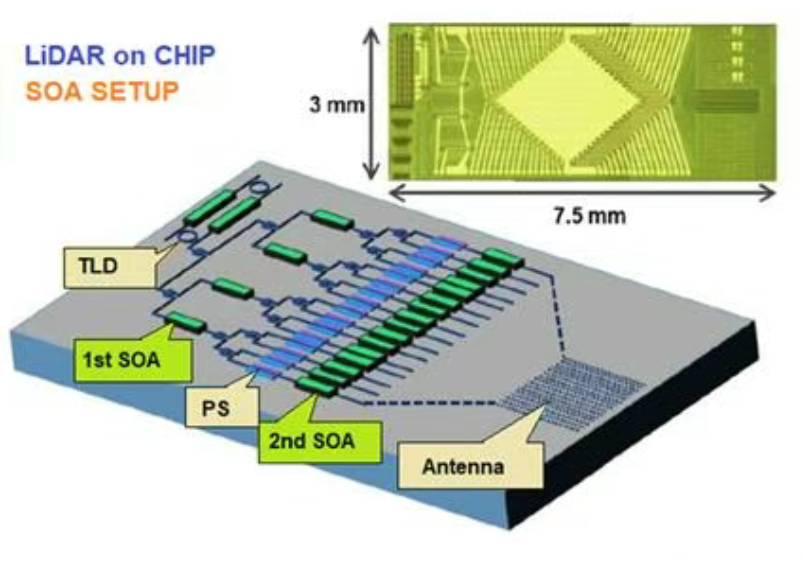The usage method of semiconductor optical amplifier (SOA) is as follows:
SOA semiconductor optical amplifier is widely used in all walks of life. One of the most important industries is telecommunications, which is valued in routing and switching. SOA semiconductor optical amplifier is also used to enhance or amplify the signal output of long-distance optical fiber communications and is a very important optical amplifier.

Basic usage steps
Select the appropriate SOA optical amplifier: Based on specific application scenarios and requirements, choose an SOA optical amplifier with suitable parameters such as working wavelength, gain, saturated output power, and noise figure. For instance, in optical communication systems, if signal amplification is to be carried out in the 1550nm band, an SOA optical amplifier with an operating wavelength close to this range needs to be selected.
Connect the optical path: Connect the input end of the SOA semiconductor optical amplifier to the optical signal source that needs to be amplified, and connect the output end to the subsequent optical path or optical device. When connecting, pay attention to the coupling efficiency of the optical fiber and try to minimize optical loss. Devices such as fiber optic couplers and optical isolators can be used to optimize optical path connections.
Set the bias current: Control the gain of the SOA amplifier by adjusting its bias current. Generally speaking, the greater the bias current, the higher the gain, but at the same time, it may lead to an increase in noise and changes in the saturated output power. The appropriate bias current value needs to be found based on the actual requirements and the performance parameters of SOA amplifier.
Monitoring and adjustment: During the usage process, it is necessary to monitor the output optical power, gain, noise and other parameters of the SOA in real time. Based on the monitoring results, the bias current and other parameters should be adjusted to ensure the stable performance and signal quality of the SOA semiconductor optical amplifier.
Usage in different application scenarios
Optical communication system
Power amplifier: Before the optical signal is transmitted, the SOA semiconductor optical amplifier is placed at the transmitting end to increase the power of the optical signal and extend the transmission distance of the system. For instance, in long-distance optical fiber communication, amplifying optical signals through SOA semiconductor optical amplifier can reduce the number of relay stations.
Line amplifier: In optical transmission lines, an SOA is placed at certain intervals to compensate for the loss caused by fiber attenuation and connectors, ensuring the quality of optical signals during long-distance transmission.
Preamplifier: At the receiving end, the SOA is placed in front of the optical receiver as a preamplifier to enhance the receiver’s sensitivity and improve its detection capability for weak optical signals.
2. Optical sensing system
In a fiber Bragg grating (FBG) demodulator, SOA boosts the optical signal to the FBG, controls the direction of the optical signal through a circulator, and senses the changes in the wavelength or timing of the optical signal caused by temperature or strain variations. In light detection and ranging (LiDAR), narrowband SOA optical amplifier, when used in conjunction with DFB lasers, can provide high output power for longer-distance detection.
3. Wavelength conversion
Wavelength conversion is achieved by utilizing nonlinear effects such as cross-gain modulation (XGM), cross-phase modulation (XPM), and four-wave mixing (FWM) of SOA optical amplifier. For instance, in XGM, a weak continuous wave detection light beam and a strong pump light beam are simultaneously injected into SOA optical amplifier. The pump is modulated and applied to the detection light through XGM to achieve wavelength conversion.
4. Optical pulse generator
In high-speed OTDM wavelength division multiplexing communication links, mode-locked fiber ring lasers containing SOA optical amplifier are used to generate high repetition rate wavelength-tunable pulses. By adjusting parameters such as the bias current of SOA amplifier and the modulation frequency of the laser, the output of optical pulses of different wavelengths and repetition frequencies can be achieved.
5. Optical clock recovery
In the OTDM system, the clock is recovered from high-speed optical signals through phase-locked loops and optical switches implemented based on SOA amplifier. The OTDM data signal is coupled to the SOA ring mirror. The optical control pulse sequence generated by the adjustable mode-locked laser drives the ring mirror. The output signal of the ring mirror is detected by a photodiode. The frequency of the voltage-controlled oscillator (VCO) is locked at the fundamental frequency of the input data signal through a phase-locked loop, thereby achieving optical clock recovery.
Post time: Jul-15-2025





